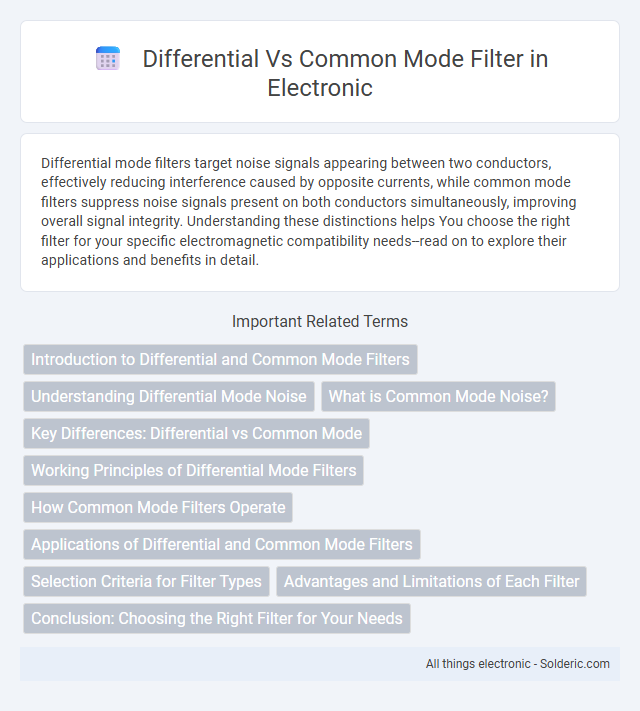Differential mode filters target noise signals appearing between two conductors, effectively reducing interference caused by opposite currents, while common mode filters suppress noise signals present on both conductors simultaneously, improving overall signal integrity. Understanding these distinctions helps You choose the right filter for your specific electromagnetic compatibility needs--read on to explore their applications and benefits in detail.
Comparison Table
| Feature | Differential Mode Filter | Common Mode Filter |
|---|---|---|
| Purpose | Suppresses differential noise between two conductors | Suppresses common noise appearing equally on both conductors |
| Noise Type | Differential mode interference | Common mode interference |
| Application | Used in signal lines carrying differential signals | Used in power lines and signal lines to reduce EMI/RFI |
| Design | Usually involves capacitors or inductors between conductors | Often consists of ferrite cores or chokes around conductors |
| Impedance Characteristics | High impedance to differential noise | High impedance to common mode noise |
| Example Components | Differential mode capacitors | Common mode chokes, ferrite beads |
Introduction to Differential and Common Mode Filters
Differential mode filters attenuate noise signals that appear between two conductors carrying opposite currents, effectively reducing electromagnetic interference (EMI) in balanced signal lines. Common mode filters target noise common to both conductors relative to ground, mitigating interference caused by external sources affecting the entire system. These filters are essential components in power supplies, data communication lines, and mixed-signal circuits to enhance signal integrity and compliance with electromagnetic compatibility (EMC) standards.
Understanding Differential Mode Noise
Differential mode noise occurs when unwanted signals appear between two conductors carrying equal and opposite currents in a circuit, causing interference primarily along the signal lines. Differential mode filters are designed to attenuate this noise by targeting the voltage difference between the conductors without affecting the common reference ground. Effective filtering of differential mode noise enhances signal integrity and reduces electromagnetic interference in high-speed data communication and sensitive electronic applications.
What is Common Mode Noise?
Common mode noise refers to unwanted electrical signals that appear identically on two or more conductors with respect to a common reference point, typically ground. This type of interference often results from electromagnetic interference (EMI) or radio frequency interference (RFI) and can degrade the performance of sensitive electronic equipment. Your device's differential vs common mode filter choice crucially impacts reducing this noise, enhancing signal integrity and minimizing interference.
Key Differences: Differential vs Common Mode
Differential mode filters target noise signals appearing between two lines carrying opposite currents, effectively suppressing interference while maintaining signal integrity. Common mode filters eliminate noise present identically on both lines relative to ground, crucial for reducing electromagnetic interference (EMI) in power and data transmission systems. The primary difference lies in their operational focus: differential mode filters address differential noise through series inductors or capacitors, whereas common mode filters utilize ferrite cores or coupled inductors to block common noise paths.
Working Principles of Differential Mode Filters
Differential mode filters operate by targeting noise signals that appear in opposite polarities on a pair of conductors, effectively suppressing electromagnetic interference (EMI) between the two lines without affecting the desired differential signal. These filters use inductors and capacitors arranged to block high-frequency noise while allowing the differential current, which flows in opposite directions, to pass with minimal attenuation. Understanding the working principles of differential mode filters can help you design circuits with improved noise immunity and enhanced signal integrity.
How Common Mode Filters Operate
Common mode filters operate by attenuating electromagnetic interference (EMI) signals that appear identically on both lines of a differential pair, allowing differential signals to pass unaffected. These filters use magnetic cores with windings arranged to create opposing magnetic flux from the common mode currents, effectively increasing impedance and dissipating unwanted noise. This selective suppression improves signal integrity in communication and power systems by reducing common mode noise without impacting differential signal performance.
Applications of Differential and Common Mode Filters
Differential mode filters are primarily applied in systems to suppress noise signals that occur between two conductors carrying differential signals, such as in data lines and audio equipment, ensuring signal integrity and performance. Common mode filters target unwanted noise signals that appear simultaneously and in phase on both conductors relative to ground, often used in power supplies, USB interfaces, and EMI reduction in communication devices. Your choice between these filters depends on the specific noise environment and the type of interference affecting your electronic system.
Selection Criteria for Filter Types
Selection criteria for differential vs common mode filters depend on the type of noise your system encounters: differential mode filters target noise signals that are opposite in phase across two lines, while common mode filters suppress noise signals that are in phase and appear simultaneously on both lines. Your choice should consider parameters such as frequency range, impedance characteristics, insertion loss, and the specific interference environment. Proper filter selection ensures optimized signal integrity and electromagnetic compatibility tailored to your application's noise profile.
Advantages and Limitations of Each Filter
Differential mode filters effectively suppress noise signals occurring between two conductors, offering precise noise reduction in balanced lines but are limited in filtering common-mode interference. Common mode filters excel at attenuating noise signals common to both conductors, improving electromagnetic compatibility in mixed signal environments though they may not address differential noise effectively. Selecting between filters depends on the dominant noise type, with differential filters providing targeted differential noise attenuation and common mode filters enhancing overall system noise immunity.
Conclusion: Choosing the Right Filter for Your Needs
Selecting the right filter depends on the specific electromagnetic interference (EMI) characteristics of your application. Differential mode filters effectively suppress noise generated between two conductors, while common mode filters target noise occurring between conductors and ground. Understanding your system's noise profile ensures your filter choice optimizes signal integrity and enhances overall device performance.
Differential vs Common Mode Filter Infographic

 solderic.com
solderic.com